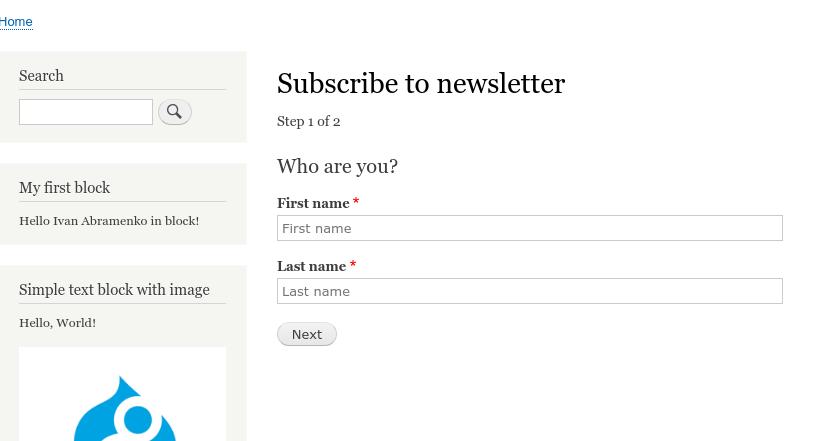9.8.2. Mehrstufiges Popup-Formular in Drupal
In diesem Artikel vertiefen wir die Form API in Drupal 8 und erstellen ein mehrstufiges Formular. Wir haben bereits ein übliches Konfigurationsformular für das Modul erstellt; ein mehrstufiges Formular wird ähnlich erstellt, indem $form_state verwendet wird, um Daten zwischen den Formularschritten zu speichern.
Code-Beispiele finden Sie auf GitHub:
https://github.com/levmyshkin/drupalbook8
Für ein mehrstufiges Formular müssen Sie eine Formular-Klasse anlegen:
/modules/custom/drupalbook/src/Form/MultiStepForm.php
<?php
namespace Drupal\drupalbook\Form;
use Drupal\Core\Form\FormBase;
use Drupal\Core\Form\FormStateInterface;
class MultiStepForm extends FormBase {
protected $step = 1;
public function getFormID() {
return 'multi_step_form';
}
public function buildForm(array $form, FormStateInterface $form_state) {
// Wrapper-Div für AJAX-Updates
$form['#prefix'] = '<div id="ajax_form_multistep_form">';
$form['#suffix'] = '</div>';
if ($this->step == 1) {
$form['message-step'] = [
'#markup' => '<div class="step">' . $this->t('Step 1 of 2') . '</div>',
];
$form['message-title'] = [
'#markup' => '<h2>' . $this->t('Who are you?') . '</h2>',
];
$form['first_name'] = [
'#type' => 'textfield',
'#title' => $this->t('First name'),
'#placeholder' => $this->t('First name'),
'#required' => TRUE,
];
$form['last_name'] = [
'#type' => 'textfield',
'#title' => $this->t('Last name'),
'#placeholder' => $this->t('Last name'),
'#required' => TRUE,
];
}
if ($this->step == 2) {
$form['message-step'] = [
'#markup' => '<div class="step">' . $this->t('Step 2 of 2') . '</div>',
];
$form['message-title'] = [
'#markup' => '<h2>' . $this->t('Please enter your contact details below:') . '</h2>',
];
$form['phone'] = [
'#type' => 'textfield',
'#title' => $this->t('Phone'),
'#placeholder' => $this->t('Phone'),
'#required' => TRUE,
];
$form['email'] = [
'#type' => 'email',
'#title' => $this->t('Email address'),
'#placeholder' => $this->t('Email address'),
'#attributes' => ['class' => ['mail-first-step']],
'#required' => TRUE,
];
$form['subscribe'] = [
'#type' => 'checkbox',
'#title' => $this->t('Subscribe to newsletter'),
];
$form['agree'] = [
'#markup' => '<p class="agree">' . $this->t('By signing up you agree to the <a href="@terms">Terms and Conditions</a> and <a href="@policy">Privacy Policy</a>', ['@terms' => '/terms-and-conditions', '@policy' => '/privacy-policy']) . '</p>',
];
}
if ($this->step == 3) {
$form['message-step'] = [
'#markup' => '<p class="complete">' . $this->t('- Complete -') . '</p>',
];
$form['message-title'] = [
'#markup' => '<h2>' . $this->t('Thank you') . '</h2>',
];
}
if ($this->step == 1) {
$form['buttons']['forward'] = [
'#type' => 'submit',
'#value' => $this->t('Next'),
'#prefix' => '<div class="step1-button">',
'#suffix' => '</div>',
'#ajax' => [
'wrapper' => 'ajax_form_multistep_form',
'callback' => '::ajax_form_multistep_form_ajax_callback',
'event' => 'click',
],
];
}
if ($this->step == 2) {
$form['buttons']['forward'] = [
'#type' => 'submit',
'#value' => $this->t('Submit'),
'#ajax' => [
'wrapper' => 'ajax_form_multistep_form',
'callback' => '::ajax_form_multistep_form_ajax_callback',
'event' => 'click',
],
];
}
$form['#attached']['library'][] = 'drupalbook/multistep_form';
return $form;
}
public function validateForm(array &$form, FormStateInterface $form_state) {
return parent::validateForm($form, $form_state);
}
public function submitForm(array &$form, FormStateInterface $form_state) {
if ($this->step == 2) {
$values = $form_state->getValues();
$email = $values['email'];
// Hier können Daten gespeichert oder E-Mails versendet werden.
}
$this->step++;
$form_state->setRebuild();
}
public function ajax_form_multistep_form_ajax_callback(array &$form, FormStateInterface $form_state) {
return $form;
}
}
Als nächstes erstellen wir eine Route für das Formular:
/modules/custom/drupalbook/drupalbook.routing.yml
drupalbook.multistep_form:
path: '/multistep-form'
defaults:
_form: '\Drupal\drupalbook\Form\MultiStepForm'
_title: 'Subscribe to newsletter'
requirements:
_permission: 'access content'
Das Formular wird dann unter /multistep-form erreichbar sein:

Damit sich das Formular in einem modalen Popup öffnet, fügen Sie einen Block oder einfachen Text mit einem Link mit der CSS-Klasse use-ajax und dem Attribut data-dialog-type="modal" hinzu, der auf die Formularseite verweist. Außerdem müssen Sie die Bibliotheken core/drupal.dialog.ajax und core/jquery.form aktivieren.
Wenn Sie das über einen Block machen, könnte der Code für den Button zum Öffnen des Popup-Formulars so aussehen:
/modules/custom/drupalbook/src/Plugin/Block/SubscribeFormButton.php
<?php
namespace Drupal\drupalbook\Plugin\Block;
use Drupal\Core\Block\BlockBase;
/**
* Provides a button subscribe to newsletter.
*
* @Block(
* id = "drupalbook_subsribe_form_button",
* admin_label = @Translation("Subscribe to Newsletter"),
* )
*/
class SubscribeFormButton extends BlockBase {
public function build() {
$text = '<a href="/multistep-form" class="use-ajax" data-dialog-type="modal">Subscribe</a>';
return [
'#markup' => $text,
'#attached' => [
'library' => [
'core/drupal.dialog.ajax',
'core/jquery.form',
],
],
];
}
}
Das Popup-Formular sieht dann so aus:

Zusätzlich wird eine eigene Bibliothek aus drupalbook.libraries.yml eingebunden:
/modules/custom/drupalbook/drupalbook.libraries.yml
multistep_form:
css:
css/multistep_form.css: {}
js:
scripts/multistep_form.js: {}
dependencies:
- core/jquery
- core/jquery.once
Um das Formular ansprechend zu gestalten und nötige jQuery-Plugins zu integrieren, müssen Sie weitere Dateien erstellen:
/modules/custom/drupalbook/css/multistep_form.css
/modules/custom/drupalbook/scripts/multistep_form.js
Code-Beispiele dazu finden Sie auf GitHub:
https://github.com/levmyshkin/drupalbook8